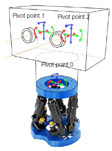METROLOGY GLOSSARY
Abbe Error
Angular deformation in bearing ways lead to a positional error of the point of interest.
Accuracy
Difference between the actual position and the desired position. Defined by ISO 230-2 standard.
Backlash error
Clearance or lost motion in a mechanism caused by gaps between the parts.
Cross coupling
When commanded to move on a single axis, defines the deviation of the hexapod position on the other axes.
Dimensional metrology
Science of calibrating and using physical measurement equipment to quantify the physical size of an object or the distance and angle from any given object.
Drift
It is a modification of position which includes different effect changes like environmental effects. The drift is often caused by thermal effect and by electronics.
Hysteresis error
It is a deviation between the actual and commanded position at the point of interest caused by elastic forces and friction forces.
Metrology
Science of measurement.
Repeatability
Deviation from the average of actual positions when the system is commanded several times to go to the desired position.
Repeatability is given as unidirectional repeatability in any point of the axis with ± 1 standard deviation (parameter R+ following ISO 230-2 standard).
Resolution
Resolution is seen as minimum incremental motion (MIM). It is the smallest motion increment that the system is able to achieve in a consistent and detectable manner.
Stability
Defines how much the hexapod deviates from its position over time without any new command.
Stiffness
Defines how much the hexapod deforms when subject to an applied force. Stiffness is determinant to increase the natural frequency.
Straightness
Defines the deviation of the hexapod position from its trajectory when commanded to move on a straight line.
MISCELLANEOUS GLOSSARY
Application Programming Interface (API)
A command line interface which allows to communicate with the hexapod controller without using the GUI.
Absolute encoder
Position feedback sensor retains position data after a power failure. Unlike an incremental encoder, there is no need to originate to give a position value.
An absolute encoder can be linear or rotary.
Graphical User Interface (GUI)
An intuitive interface which allows the user to control the hexapod.
Hexapod
Parallel kinematics system composed of six struts to provide motion and accuracy for positioning in the six Degrees Of Freedom (6 DOF) also called Gough-Stewart platform or Stewart platform.
Invar
Invar is a nickel–iron alloy (Fe36Ni – 64FeNi in the USA) notable for its uniquely low coefficient of thermal expansion. The name Invar comes from the word invariable, referring to its relative lack of expansion or contraction with temperature changes.
Parallel kinematics
A parallel kinematics system is a mechanical system that uses several (at least two) computer-controlled serial chains to support a single platform, or end-effector. Compared to a serial kinematics system in which each degree of freedom is dependent, the degrees of freedom in a parallel kinematics system are interdependent.
Pivot point
Center of rotation around which the hexapod applies the motions. It can be configured virtually via software.

Six Degrees Of Freedom (6 DOF)
It refers to the freedom of movement of a body in a three dimensional space. The body is free to move forward/backward, left/right, up/down, combined with rotations about three perpendicular axes, often termed roll, pitch and yaw.

